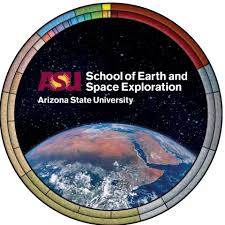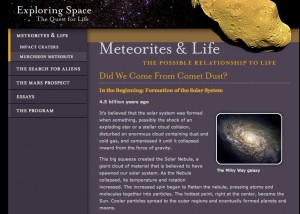Videos, websites and presentations
Videos
Websites
Ask an Earth and Space Scientist
 Learn about research in the ASU School of Earth and Space Exploration!
Learn about research in the ASU School of Earth and Space Exploration!
Includes Meteorites: Space Rocks, produced by Center-affiliated PhD Candidates Soumya Ray and Zachary Torrano.
NASA at Home
Image: NASA
Offering videos, ebooks, podcasts, virtual tours, and much more.
NASA STEM Engagement
Image: NASA/STEM
NASA’s journeys have propelled technological breakthroughs, pushed the frontiers of scientific research, and expanded our understanding of the universe. These accomplishments, and those to come, share a common genesis: Education in science, technology, engineering, and math.
[expand title=”More information” tag=”u” trigclass=”arrowright” targclass=”div”]NASA STEM Engagement seeks to:
- Create unique opportunities for students and the public to contribute to NASA’s work in exploration and discovery.
- Build a diverse future STEM workforce by engaging students in authentic learning experiences with NASA people, content, and facilities.
- Strengthen public understanding by enabling powerful connections to NASA’s mission and work.
To achieve these goals, NASA STEM Engagement strives to increase K-12 involvement in NASA projects, enhance higher education, support underrepresented communities, strengthen online education, and boost NASA’s contribution to informal education.[/expand]
National Informal STEM Education (NISE) Network
 In collaboration with NASA, the National Informal STEM Education (NISE) Network have assembled a new set of engaging, hands-on Earth and space science experiences with connections to science, technology, and society, as well as tips for leading hands-on activities.
In collaboration with NASA, the National Informal STEM Education (NISE) Network have assembled a new set of engaging, hands-on Earth and space science experiences with connections to science, technology, and society, as well as tips for leading hands-on activities.
https://www.nisenet.org/earthspacekit
[expand title=”More information” tag=”u” trigclass=”arrowright” targclass=”div”]NISE Network products are developed through an iterative collaborative process that includes scientific review, peer review, and visitor evaluation in accordance with an inclusive audiences approach. Products are designed to be easily edited and adapted for different audiences under a Creative Commons Attribution Non-Commercial Share Alike license. To learn more, visit the NISE Development Process page.[/expand]
Impact Craters Teacher Page
Informational website hosted by Hawai’i Institute of Geophysics and Planetology, giving an overview of impact craters, their formation, morphology and subsequent modification.
http://www.spacegrant.hawaii.edu/class_acts/CratersTe.html
Chicxulub Impact Event – Understanding the K-T Boundary
![]() The Lunar and Planetary Institute has posted online a large collection of classroom resources related to the K-T boundary, Chicxulub crater, and impact cratering processes.
The Lunar and Planetary Institute has posted online a large collection of classroom resources related to the K-T boundary, Chicxulub crater, and impact cratering processes.
https://www.lpi.usra.edu/science/kring/Chicxulub/students-teachers/
Utah Geological Survey
Information on meteorites and meteorwrongs from the Utah Geological Survey.
https://geology.utah.gov/map-pub/survey-notes/glad-you-asked/meteorite-or-meteorwrong/
NASA Astronomy Picture of the Day
Discover the cosmos! Each day, a different image or photograph of our fascinating universe is featured, along with a brief explanation written by a professional astronomer.
https://apod.nasa.gov/apod/astropix.html
NASA Image Archive
https://www.nasa.gov/multimedia/imagegallery/index.html
Verde Valley Archaeology Center
http://verdevalleyarchaeology.org/spacerocks
Presentations
Space Rocks Presentation
Space Rocks: Impacts of our smallest neighbors
 Use this Night Sky Network presentation in conjunction with the activities included in the Space Rocks ToolKit or on its own. Presentation about our smallest neighbors, the properties of comets and asteroids, how we are searching for them, the potential hazards of Near-Earth Objects (NEOs), and what we might do to avoid future impacts.
Use this Night Sky Network presentation in conjunction with the activities included in the Space Rocks ToolKit or on its own. Presentation about our smallest neighbors, the properties of comets and asteroids, how we are searching for them, the potential hazards of Near-Earth Objects (NEOs), and what we might do to avoid future impacts.
https://nightsky.jpl.nasa.gov/download-view.cfm?Doc_ID=464
PBS Meteorites & Life
 Comets and meteors have been raining debris on Earth for billions of years, and scientists think they just may be the vehicles that carried the “stuff of life” to the planet. Explore the timeline of the Murchison meteorite and the significant discoveries that may begin to answer the question of how life came to be here.
Comets and meteors have been raining debris on Earth for billions of years, and scientists think they just may be the vehicles that carried the “stuff of life” to the planet. Explore the timeline of the Murchison meteorite and the significant discoveries that may begin to answer the question of how life came to be here.
http://www.pbs.org/exploringspace/meteorites/murchison/index.html

